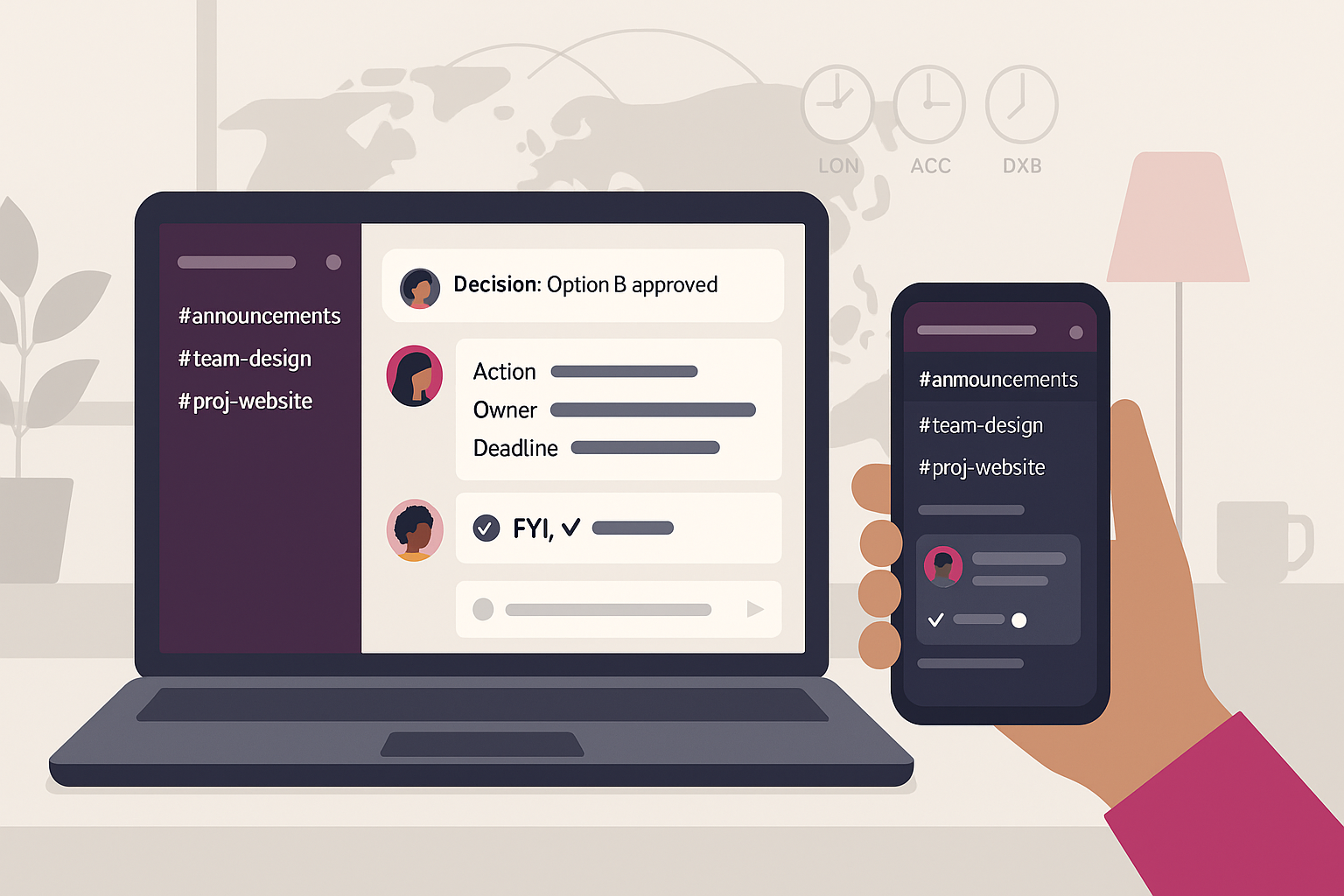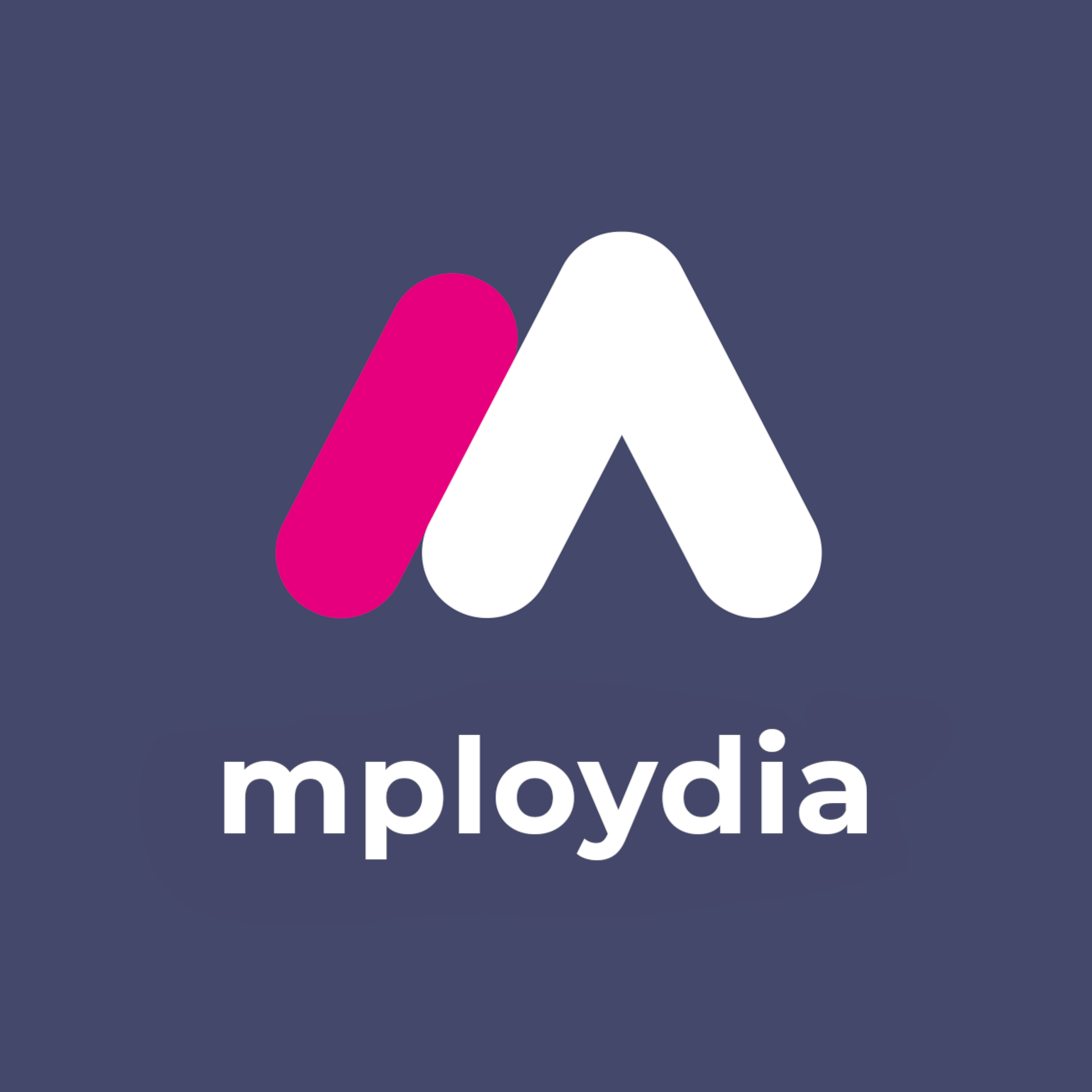
Slack Etiquette for Hybrid Teams [Essential Rules and Tips]
Introduction
Slack can make hybrid teams fly or fail fast. Which side you land on is not about the tool. It is about behaviour. Hybrid work adds time zones, flexible hours and fewer casual cues. Without clear etiquette, Slack becomes noisy, brittle and stressful. With it, teams move faster, reduce meetings and avoid burnout. This playbook gives you precise rules, templates and checklists to install in your team today. Why this matters if you are new to work: learn these habits early and you will look professional from day one.
Why Slack etiquette matters in hybrid teams
Hybrid is both asynchronous and synchronous. That duality is powerful if you set rules. It is chaos if you do not. Slack etiquette protects attention, preserves context and keeps decisions visible.
- Speed: clear requests reduce back-and-forth and handover delays across time zones.
- Quality: written context improves decisions and reduces rework.
- Inclusivity: documented threads let remote and quiet voices contribute.
- Well-being: reduced notification noise and fewer unnecessary meetings lower stress.
- Onboarding: a clean channel structure is a self-serve training resource.
Core principles you will enforce
- Default to public channels. Keep work in channels, not DMs. Use DMs for sensitive, personal or one-to-one topics. Summarise outcomes back to the relevant channel.
- Asynchronous first. Write clear, complete messages that enable progress without a live call. Move to a huddle only when typing is slower than talking, or decisions are blocked.
- Respect time zones and working windows. Share your hours in your profile. Use scheduled send outside others’ core hours. Never expect instant replies.
- Control notifications. Use mentions sparingly. If you need a group, use a user group mention. Avoid @channel unless the message is urgent and relevant to everyone. Use @here only when action is needed from those currently online.
- One topic per thread. Start a new thread for each topic. Keep the channel clean. When resolved, post a one-line conclusion to the channel.
- Lead with the ask. Put the action, owner and deadline at the top of the message. Add context below. Make it skim-friendly.
- Decide in writing. Record the decision, owner and date in the thread. Add a bookmark or pin. Link to the doc or ticket.
- Status tells the truth. Keep your Slack status accurate. Include return time for away statuses. Respect colleagues’ Do Not Disturb windows.
- Reduce duplication. Link to source docs rather than pasting the same text into multiple channels. Cross-post only when necessary and always reference the original thread.
- Be direct and courteous. No sarcasm. Assume good intent. Critique the work, not the person.
Channel architecture that scales
Your channel list is your operating system. Name channels consistently. Make the purpose obvious at a glance.
- Announcements: #announcements company-wide broadcast. Posting restricted to a few owners. Use thread for Q&A. Post a weekly digest. #team-announcements for team-level updates.
- Teams and functions: #team-ops, #team-design, #team-finance. Day-to-day collaboration lives here.
- Projects: #proj-website-rebuild, #proj-client-omega. Archive 30 days after completion and post a final summary before archiving.
- Help and support: #help-it, #help-data, #help-hr. Promise a response-time target and staff it.
- Topics and communities: #topic-ai, #topic-accessibility. Knowledge sharing and practice communities.
- Social and culture: #social, #wellbeing. Keep it healthy and inclusive.
- Locations and time zones: #geo-london, #geo-accra. Local notices and meetups.
- External collaboration: Use Slack Connect with partners. Name channels with a clear prefix like #x-client-omega.
Channel policies you should publish
- Every channel has a clear description, owner and purpose.
- Pin a short channel guide: purpose, response expectations, naming rules, links.
- Use bookmarks for key docs and dashboards.
- Limit posting in #announcements. Always include action, audience, and deadline.
- Archive or rename stale channels quarterly. Keep the list lean.
Message formatting that works
Write for scanning. Make the first two lines carry the request. Use short paragraphs. Use bullet points. Avoid dense blocks of text.
Structure for requests
- Action: what you need, by when, and why it matters
- Owner: who is on the hook
- Context: link to the relevant doc or ticket
- Constraints: dependencies, risks or boundaries
- Confirmation: ask for a quick acknowledgement reaction
Example
- Action: Please review the attached draft press release by 16:00 Wednesday.
- Owner: @amelia as primary, @dev-team for technical accuracy.
- Context: Link to doc. Focus on the pricing paragraph, sections 3 and 5.
- Constraints: We must meet the client’s embargo date on Friday.
- Confirmation: React with a tick when your review is complete.
Structure for status updates
- TLDR: one-line status and what changed
- Progress: what you completed
- Blockers: what is stuck and what help you need
- Next: the next two actions with owners
- Links: tickets, docs, dashboard
Structure for decisions
- Decision: one-line statement
- Rationale: why we chose it
- Owner: who will deliver and by when
- Impact: what changes and who is informed
- Link: doc or task where the decision is captured
Structure for escalations
- Issue: what is broken
- Impact: who is affected and how badly
- Ask: the specific help needed
- Time: the deadline before impact worsens
- Context: links to logs, tickets, evidence
Threads, reactions and DMs
Threads keep channels readable. Always reply in thread. Do not split the same topic across new channel messages. When you reach a conclusion, post a one-line summary back to the channel with the final decision and link to the thread.
Reactions are signals. Use a tick as confirmation of completion. Use an eyes reaction to show you are reviewing. Use a question mark reaction to indicate unclear instructions and prompt clarification. Avoid using reactions for decisions. Decisions must be written in the thread.
DMs are for sensitive or personal matters. Do not bury work decisions in DMs. If a DM contains useful information, post a summary to the relevant channel.
Timing, response expectations and boundaries
Set explicit response-time targets per channel type, publish them, and hold each other to them.
Suggested targets
- #help- channels: first response within two working hours, resolution time target defined by the team.
- #team- channels: reply within one working day.
- #proj- channels: reply within four working hours during project active phase.
- DMs: reply within one working day unless marked urgent.
- #announcements: no response required unless asked for an action.
Core hours and schedule send
- Define team core hours when overlapping time zones allow live discussion, for example 12:00 to 16:00 UK time.
- Use scheduled send outside someone’s core hours. Respect Do Not Disturb. Do not expect weekend responses unless explicitly on-call.
- If you must send something urgent out of hours, mark the message clearly with [URGENT] and explain why.
Notification hygiene
Protect attention. It is your scarcest resource.
- Star priority channels and people. Review starred items weekly.
- Mute noisy channels that are not critical. You can still read them when you choose.
- Use keyword notifications for critical topics or client names.
- Create user groups like @team-product to avoid long lists of mentions.
- Never tag people without a reason. One clear owner is better than tagging five people.
- Use a short prefix to signal urgency. Suggested: [FYI] no action, [ACTION] needs work, [DECISION] final, [INFO-REQ] needs information, [URGENT] immediate action.
When to switch: message, huddle or meeting
Start async. Switch to a huddle when:
- The topic needs live back-and-forth and is urgent.
- A decision is blocked by confusion.
- You need to pair on a task for a short burst.
Huddle etiquette
- Post the agenda in a thread before you start.
- Keep it under 15 minutes by default.
- Summarise outcomes and decisions in the thread when finished.
- Invite only the people who are essential.
Meeting thresholds
- If it needs more than 15 minutes, multiple stakeholders and a pre-read, schedule a meeting with a clear agenda, pre-work and decisions required. Post notes and decisions back to Slack with owners and deadlines.
Files, links and searchability
Slack is only useful if information is findable. Treat it like a knowledge base.
- Use clear filenames with dates and versions, for example client-omega-brief-v2-2025-01-20.docx.
- Add a one-line description when you upload a file. Include the purpose and status.
- Link to the source of truth, not a local copy. Avoid duplicates.
- Use bookmarks in the channel for key docs, dashboards and runbooks.
- Add alt text for images so everyone can understand content.
- Move final artefacts to your document store and link it. Slack is not your long-term archive.
Security, compliance and professionalism
- Do not post confidential data in public channels. Use private channels for restricted topics and limit membership.
- Verify identities before adding external guests. Use Slack Connect for partners and set clear rules of engagement.
- Respect your organisation’s retention and export policies. Avoid discussing personal data unless necessary and lawful.
- Editing and deletion etiquette: correct typos with edits, not deletions. If you must delete for sensitivity, post a brief note explaining why.
- Follow your code of conduct. Report harassment or inappropriate messages via the proper process.
Onboarding checklist for new joiners
Set them up to succeed on day one.
- Complete your profile: full name, role, team, location, time zone, short bio.
- Set your working hours and enable Do Not Disturb.
- Join required channels: #announcements, #team-<function>, #help-<relevant>, #proj-<current>.
- Read pinned posts and bookmarks in each channel.
- Review the Slack etiquette policy and channel naming guide.
- Configure notifications: star key channels, mute non-essential ones, set keywords.
- Install required apps and connect calendar and project tools.
- Post a short introduction in #team- and #social with your working hours and how you like to collaborate.
Quick reference: do and do not
Do
- Keep work in public channels.
- Lead with the ask, owner and deadline.
- Use threads for each topic and post a final summary.
- Respect time zones and Do Not Disturb.
- Use reactions as lightweight signals, not as decisions.
- Pin and bookmark important items.
- Use schedule send for out-of-hours messages.
- Archive stale channels.
Do not
- Spray @channel for non-urgent items.
- Split one topic across multiple threads.
- Hide decisions in DMs.
- Expect instant responses.
- Dump files without context.
- Post sensitive data in public spaces.
- Use sarcasm or vague language.
Slack etiquette templates you can copy
Request for input
- Action: Need your review on the Q2 metrics dashboard by 15:00 Thursday.
- Owner: @alex for accuracy, @jamal for narrative.
- Context: Link to dashboard. Focus on sections 2 and 4.
- Constraints: Must align with board pack on Friday.
- Confirmation: Please react with a tick when done.
Status update
- TLDR: Project Omega is on track. Design complete, dev at 60 percent, no critical risks.
- Progress: Completed user flows and API contract.
- Blockers: Waiting on security review results due Wednesday.
- Next: Dev to finish authentication module by Friday. Marketing to prepare launch brief by Monday.
- Links: Tickets and doc links here.
Decision log
- Decision: We will use Option B for the payment provider.
- Rationale: Lower fees and simpler integration.
- Owner: @nina to sign contract by 28 Feb.
- Impact: Update risk register, notify finance and support teams.
- Link: Procurement ticket and contract draft.
Escalation
- Issue: Daily builds are failing on the main branch.
- Impact: Team blocked from merging. Release date at risk.
- Ask: Need a temporary revert and a hotfix owner.
- Time: Must resolve by 12:00 today to keep schedule.
- Context: Build logs and failing tests linked.
Huddle invite
- Agenda: Align on the client timeline and scope cuts.
- People: @pm, @tech-lead, @design-lead.
- Timebox: 10 minutes.
- Outcome: Confirm scope and publish updated plan.
Troubleshooting common Slack failures
- No one replies to your message: Your ask is unclear. Rewrite with a clear action, owner and deadline. Add context and a link. Tag the single person accountable, not the whole team.
- Threads go on forever: The problem is undefined. Post a summary, define the decision needed, and propose options with pros and cons. Call a 10-minute huddle if stuck.
- Channel is too noisy: The channel purpose is unclear. Update the description. Pin a channel guide. Create a separate #announcements or #help channel. Set response-time expectations.
- People keep using DMs: They fear judgement or do not know where to post. Model public posting yourself. Thank others who share in channels. Move DM decisions to channels with a brief summary.
- Missed critical message: Overuse of mentions or poor labelling. Use urgency prefixes. Create a user group for the right audience. Do a weekly digest.
- Confusion after huddles: No written outcome. Post a thread summary with decisions, owners and deadlines.
Making Slack inclusive
- Write plainly. Avoid jargon and acronyms unless defined.
- Share decisions in writing so remote and part-time colleagues can contribute.
- Use alt text on images. Describe charts in one line.
- Be mindful of cultural differences and tone. Read before sending.
- Invite input from quieter voices by asking direct, respectful questions in threads.
- Keep social channels respectful and open to all.
A lightweight policy you can copy
- Purpose: Slack is our default workspace for sharing context, making decisions and coordinating work.
- Principles: Public by default, asynchronous first, clarity over speed, inclusive by design.
- Mentions: Tag the accountable owner. Avoid group spam. Use user groups for teams.
- Threads: One topic per thread. Post a final summary to the channel when resolved.
- Decisions: Written in the thread with owner, date and link. Pinned or bookmarked.
- Response: Respect time zones. Use the channel’s response target. Schedule send out-of-hours.
- Security: No sensitive data in public channels. Use private channels and Slack Connect rules for external parties.
- Clean-up: Archive inactive channels quarterly. Curate bookmarks and pins.
Final thought
Slack discipline is not bureaucracy. It is speed with clarity. Hybrid teams that master etiquette reduce meetings, cut noise and build trust. Adopt these rules, publish them, and hold each other to them. New to the workplace or moving into hybrid for the first time, this is how you look like a pro from day one.
Next Steps
Want to learn more? Check out these articles:
10 Tips for Demonstrating Great Communication Skills to Employers
Mastering Communication Skills for Workplace Success: A Blueprint for Professionals
Check out our Advanced Employability Course for all the help you need to get your dream job, fast.


